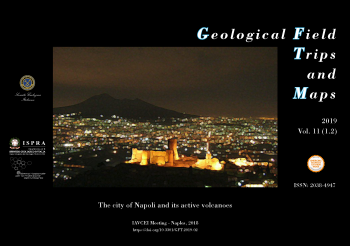
Volume 11 (1.2)/2019
The city of Napoli and its active volcanoes
IAVCEI Meeting - Naples, 2018
DOI: https://doi.org/10.3301/GFT.2019.02 - Pages: 1-107
Raffaello Cioni (1), Roberto Isaia (1), Roberto Sulpizio (3). With contributions of: Sandro de Vita (2), Mauro A. Di Vito (2), Marco Pistolesi (4), Victoria Smith (5), Mike Stock (6) & Pierfrancesco Talamo (2)
(1) - Dipartimento di Scienze della Terra, Università di Firenze (Italy).
(2) - INGV, Osservatorio Vesuviano, Napoli (Italy).
(3) - Dipartimento di Scienze della Terra e Geoambientali, Università di Bari (Italy).
(4) - Dipartimento di Scienze della Terra, Università di Pisa (Italy).
(5) - Research Laboratory for Archaeology and the History of Art, University of Oxford (UK).
(6) - Dept. Earth Sciences, University of Cambridge (UK).
(2) - INGV, Osservatorio Vesuviano, Napoli (Italy).
(3) - Dipartimento di Scienze della Terra e Geoambientali, Università di Bari (Italy).
(4) - Dipartimento di Scienze della Terra, Università di Pisa (Italy).
(5) - Research Laboratory for Archaeology and the History of Art, University of Oxford (UK).
(6) - Dept. Earth Sciences, University of Cambridge (UK).
Abstract
Somma-Vesuvius and Campi Flegrei are among the most famous active volcanoes in the world and are part of the Neapolitan landscape. The activity of the volcanoes punctuated the human history since Bronze Age, as testified by archaeological finds recognised in the plain and relieves surrounding the volcanic area. The world-famous eruption of AD 79 consigned the Somma-Vesuvius to the history, because of the burying of some important roman tows like Pompeii and Herculaneum. The field trip dedicated to Somma-Vesuvius illustrates the volcanology of main historical eruptions, with special emphasis to the activity of the last 4000 years. The visit to the summit cone provides a panoramic view of the inner caldera wall. Deposits of the Plinian and subplinian eruptions can be observed in old quarries around the volcano. The AD 79 deposits are exposed in both quarries and archaeological excavations such Herculaneum and Oplontis, in which the interaction of the pyroclastic deposits with an inhabited area will be the argument for discussion about the present day volcanic hazard and risk in the Neapolitan area. A visit to the hystorical site of the Osservatorio Vesuviano will be the occasion to illustrate the born and the history of volcanic surveillance.
The itinerary in the Campi Flegrei caldera, provides asn overview of i) the deposits of the Campanian Ignimbrite and Neapolitan Yellow Tuff caldera forming eruptions, ii) the pyroclastic density currents and fallout deposits of the post caldera volcanism, iii) different preserved volcano edifices and volcano tectonic structures, along with fumarolic and hydrothermal active field are hosted. A visit to the remnants of the Serapeum Roman market and the Pozzuoli harbour, are the best examples to discuss of caldera unrest at Campi Flegrei. The several diverse monitoring stations site at Solfatara and a visit to the Monitoring Centre of the Osservatorio Vesuviano provide an opportunity to illustrate the surveillance network of the INGV-OV for the Neapolitan volcanoes and discuss on the future eruption scenario and the related risk.
Keywords
Vesuvius, Campi Flegrei, active volcanoes, volcanic deposits, caldera, volcanic edifice, volcanic stratigraphy, volcanic hazards.
